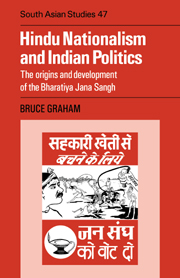Book contents
- Frontmatter
- Contents
- List of illustrations
- List of tables
- Preface
- List of abbreviations
- 1 The challenge of Hindu nationalism
- 2 The immediate origins of the Jana Sangh
- 3 The doctrinal inheritance of the Jana Sangh
- 4 The leadership and organization of the Jana Sangh, 1951 to 1967
- 5 The Jana Sangh as a Hindu nationalist rally
- 6 The Jana Sangh and interest-group politics
- 7 The Jana Sangh in electoral politics, 1951 to 1967
- 8 Conclusion
- Appendix I
- Appendix II
- Appendix III
- Appendix IV
- Select Bibliography
- Index
- CAMBRIDGE SOUTH ASIAN STUDIES
4 - The leadership and organization of the Jana Sangh, 1951 to 1967
Published online by Cambridge University Press: 06 July 2010
- Frontmatter
- Contents
- List of illustrations
- List of tables
- Preface
- List of abbreviations
- 1 The challenge of Hindu nationalism
- 2 The immediate origins of the Jana Sangh
- 3 The doctrinal inheritance of the Jana Sangh
- 4 The leadership and organization of the Jana Sangh, 1951 to 1967
- 5 The Jana Sangh as a Hindu nationalist rally
- 6 The Jana Sangh and interest-group politics
- 7 The Jana Sangh in electoral politics, 1951 to 1967
- 8 Conclusion
- Appendix I
- Appendix II
- Appendix III
- Appendix IV
- Select Bibliography
- Index
- CAMBRIDGE SOUTH ASIAN STUDIES
Summary
The central paradox of Indian politics in the 1950s and 1960s is that the party system, although highly differentiated in terms of programmes and doctrines, was unable to organize the mass electorate into clearly defined and separated sectors of social and regional support. With some exceptions, the political parties appeared to float above society, unable to establish a durable and electorally rewarding relationship with the groups whose interests they claimed to represent. Organizational activity, punctuated by membership drives, executive meetings and large plenary sessions, gave an impression of vitality, but behind these outward forms the party structures lacked substance.
Why were so many parties unable to establish secure social bases for themselves? Part of the explanation is that the Congress Party was very successful in its attempts to inhibit the development of opposition; as the governing party, it had unmatched resources for patronage and influence, which it could use to support or undermine local factions, and during the run-up to an election it could operate like a great machine, using its wealth and prestige to ensure that its candidates were well supported and well financed in every region. It tended not to rely on zones of safe seats or on established sitting members, but to campaign everywhere, and to compensate for some inevitable losses by taking seats from opposition incumbents and Independents. The result was a quite exceptional turnover of seats, which made it very difficult for non-Congress parties to anchor themselves in particular regions or localities.
- Type
- Chapter
- Information
- Hindu Nationalism and Indian PoliticsThe Origins and Development of the Bharatiya Jana Sangh, pp. 53 - 93Publisher: Cambridge University PressPrint publication year: 1990

